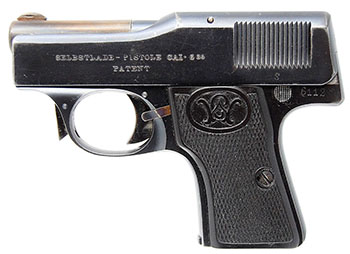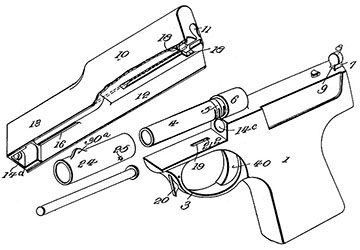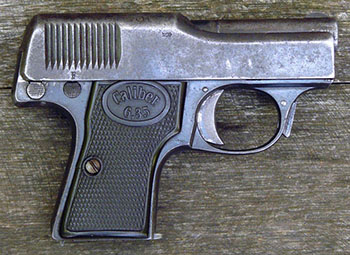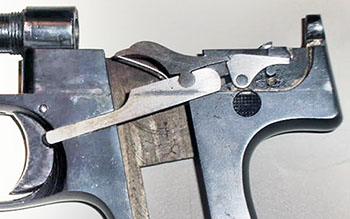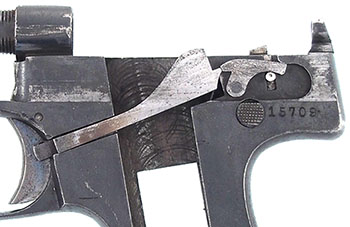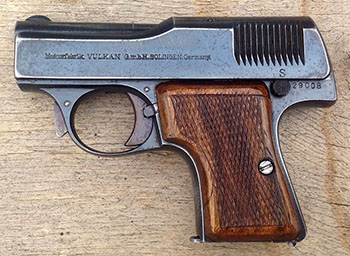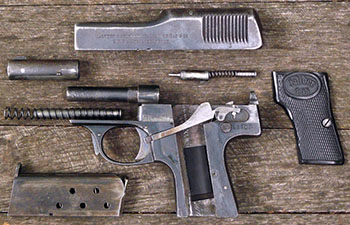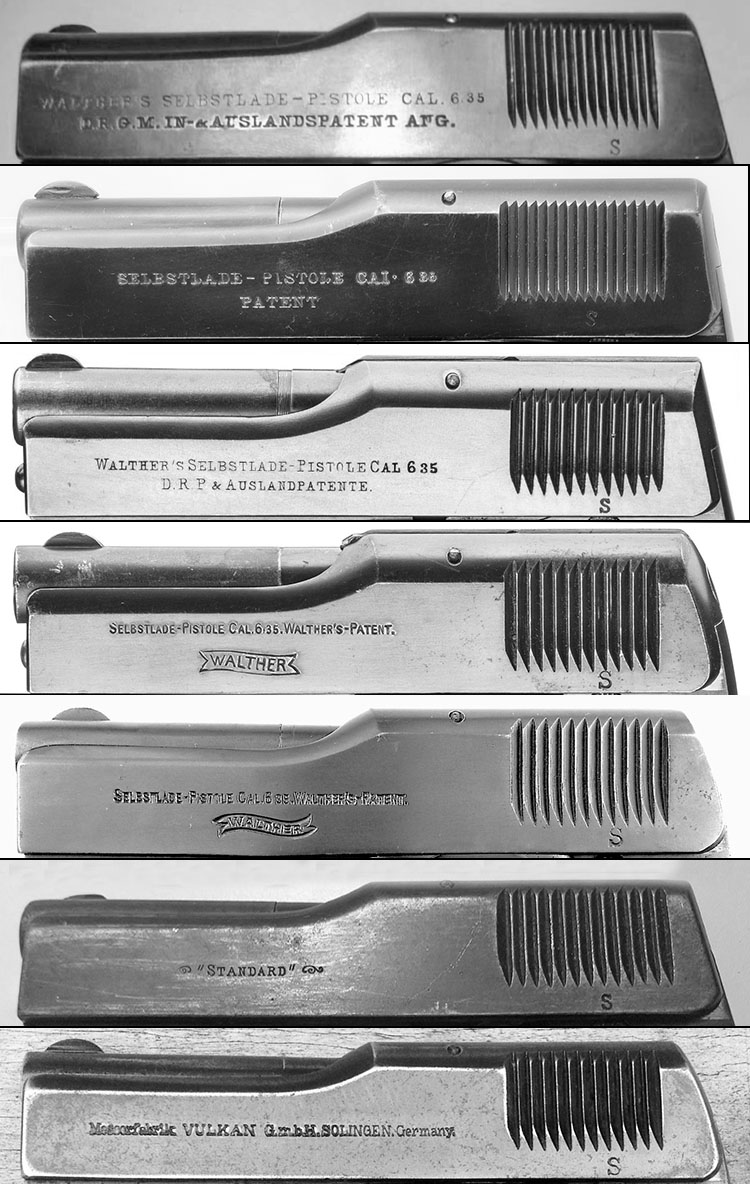 |
||||||||||||||||||||||||||||||||||||||||||||||||||||||||||||||||||||||||||||||||||||||||||||||||||||||||||||||||||||||||||||||||||||||||||||||||||||||||||||||||||||||||||||||||||||||||||||||||||||||||||||||||
|
The Walther Model 1
German patent number 235944 for an ”automatic firearm with a fixed barrel” was applied for on 8 August 1909 in the name of Carl Walther, and granted on 22 June 1911. The U.S patent (991398) was applied for on 9 June 1910 granted on 2 May 1911.
Interestingly, the patent covers only the frame and slide design and the method of disassembly. The lockwork of the Model 1, which to my knowledge was unique in its era, was never patented, though it may have been covered by a gebrauchsmuster (see below). The gun was originally marketed as the “Deutsche Selbstlade Pistole Walther, Modell 1909, Kaliber 6,35.” In 1914, when the Walther Model 2 appeared, the original Walther pistol was retroactively named the Model 1. The Walther Model 1 has a fixed barrel and an open-top slide with sides that extend forward to enclose a recoil spring located beneath the barrel. The gun is striker-fired and has a “doll’s head” backstop for the striker spring virtually identical with that on the 1906 FN Browning. Unusual features
Variations Gene Gangarosa distinguishes five variations of the Model 1, based on slide inscriptions, but Dieter Marschall, who has emerged as the current expert on Walther Pistols, only distinguishes two, based on external buttons: one button (safety) or two buttons (safety and take-down button). I am going to go with Marschall’s terminology, and try to document the sub-variants. Corrections, additional information, and more extensive photographs are most welcome.* First Variation (One Button)
The front crosspiece of the slide rests on the flat portion of the frame above the trigger guard bow, and the integral breech block rests on the rear portion of the upper frame. There are no guide rails on the frame of the Model 1. But it is carefully crafted and closely fitted. The “doll’s head” and striker fit in a hole bored in the breech block. The “doll’s head,” the barrel sleeve, and the recoil spring guide rod maintain the slide in position on the frame. There is a small stud on the left side of the barrel sleeve that runs in a groove in the the left arm of the slide. Disassembly of the First Variation is accomplished by removing the barrel sleeve and drawing the slide back just enough for the “doll’s head” to fit through a cut in the bottom rear of the breech block, so the slide can be lifted up and removed toward the front.
The earliest guns I have documented feature 15 triangular-cut slide serrations on either side, which do not extend all the way to the bottom of the slide, but there is considerable variation in early guns, including guns with 13 coarse and 17 somewhat finer serrations. The earliest left side slide inscription I have documented is in all-capital serif characters as follows: WALTHER’S SELBSTLADE-PISTOLE CAL. 6.35 The above inscription indicates that a gebrauchsmuster (a short-term utility patent) has been registered in Germany and patents have been applied for outside of the country. The only gebrauchsmuster we have located for Walther in this period is dated 1912, for a handgun trigger device— this would be too late to apply to the Model 1. The above inscription soon gives way to the following: WALTHER’S SELBSTLADE-PISTOLE CAL: 635 The above inscription indicates patents have been granted both in Germany and in other countries. Also noted is a much simpler inscription which omits the Walther name: SELBSTLADE-PISTOLE CAL. 6.35 Guns with this simplified inscription were likely intended to be sold by retailers who might wish to add their own brand name to the slide, or perhaps add their own grip plates. One such retailer was August Stukenbrok, who advertised the Walther pistol in their 1912 catalog with an illustration featuring their tradename “Aste” on the grips. However, no such gun has ever been located. A Bial & Freund advertisement of unknown date also shows a Walther Model I pistol with what appear to be grip plates with a “B&F” monogram though, again, no such gun has been documented. I have documented a single specimen with only the word “STANDARD” on the slide, and also a couple of specimens lacking an inscription altogether. Early guns proofed prior to 1 September 1911 have the double-crown-over-U proof mark on the right side of the slide in front of the chamber. After 1 September 1911 the crown-over-N nitro proof mark is found. According to Marschall, the change from double-crown-over-U to crown-over-N took place around serial number 3500. Please contact me if you have a gun in this serial number range.* I know that serial number 3502 has the crown-over-N proof but I also know that guns were not always proofed in serial number order. Grip plates are of checkered hard rubber with the CW monogram in an oval at the top. Guns in an uncertain range somewhere between 4000 and 6200 are marked on the right side of the frame, just behind the safety button in all-capital sans-serif characters: WALTHER’S PATENT Around serial number 7000 we find guns with 12 rather coarse triangular-cut slide serrations. Later still we find 13 coarse serrations.
The one button variation was made through at least serial number 14506. Dieter Marschall states that the Second Variation begain around serial number 15500. Please contact me if you have a gun in this range that would give us more precise information on when the First Variation ended.* Second Variation (Two Button) The early two-button guns display very few differences
Some grip plates have an oval at the top with “CALIBER 6,35” instead of the CW monogram. In my experience, these are much more scarce than the monogram grip plates, and may have been intended for use by retailers marketing the gun under their own brand name. So far as I know, this was a practice only allowed by Walther for their two earliest pistols, the Model 1 and the Model 3. The slide inscription remains the same as the late First Variation guns, typically showing: WALTHER’S SELBSTLADE-PISTOLE CAL: 635 Somewhere between serial numbers 18150 and 19000 (please write if you can help clarify this change*) we begin to see guns that display the following one-line slide inscription above the Walther banner: SELBSTLADE-PISTOLE CAL.6,35 WALTHER’S-PATENT. The banner is curved slightly, but not as much as the modern Walther banner, so it is known as the “flat” banner, even though it is not perfectly flat. Sometime after serial number 23736 we begin to find a different inscription with no banner, as follows: SELBSTLADE-PISTOLE CAL.635 Gangarosa maintains that guns with the above inscription, with no banner, were sold only in Austria, and most guns I have documented with this inscription do bear Austrian proofs, however I have observed guns with the late Walther banner that also bear Austrian proofs. Then, in the 26000 range we begin to find a modern fully curved Walther banner with a one-line inscription above it in sans-serif characters: SELBSTLADE-PISTOLE CAL.635.WALTHER’S-PATENT.
According to Manfred Kersten, “The Walther banner...was applied for on 8 October 1912 and registered as a protected trademark on 12 November 1912.” This indicates that the banner would not have been seen on the Model 1, even in its early form, until very late in 1912. Few Model 1 pistols were exported outside of Europe. I have observed only very late pistols in the 28000 to 29000 range that sometimes bear an export stamp on the right side of the slide: MADE IN GERMANY Marschall states that the Model 1 Second Variant serial numbers run from approximately 15500 to 31000. Please write to me if you can help make these figures more precise.* Vulcan
Messerfabrik VULKAN G.m.b.H. SOLINGEN. Germany The right side reads: TENSON Messerfabirk Vulkan G.m.b.H (The Vulkan Knife Factory) is listed in Die Werkzeugmaschine, Volume 8 (April 1904) as having previously been named Vereinigte Messerfabriken G.m.b.H (United Knife Factory). Very little is known about these pistols. The numbers on these guns appear to be in the standard Walther series, but the only ones I have observed are very high serial numbers. Walther Model 3 pistols are also found with identical markings. Field Stripping
Note: On guns with the later lockwork, once the slide is removed the lever which operates the sear can easily come off its pivot which will allow the sear and sear spring to launch from the rear of the frame. Take care not to lose these small parts. * Please write to me if you can offer additional information on the Walther Model 1. Photographs are greatly appreciated. Dating the Early Walther Pistols, Model 1-7
|
||||||||||||||||||||||||||||||||||||||||||||||||||||||||||||||||||||||||||||||||||||||||||||||||||||||||||||||||||||||||||||||||||||||||||||||||||||||||||||||||||||||||||||||||||||||||||||||||||||||||||||||||
|
Copyright 2010-2023 by Ed Buffaloe. All rights reserved. |
||||||||||||||||||||||||||||||||||||||||||||||||||||||||||||||||||||||||||||||||||||||||||||||||||||||||||||||||||||||||||||||||||||||||||||||||||||||||||||||||||||||||||||||||||||||||||||||||||||||||||||||||
|
|
||||||||||||||||||||||||||||||||||||||||||||||||||||||||||||||||||||||||||||||||||||||||||||||||||||||||||||||||||||||||||||||||||||||||||||||||||||||||||||||||||||||||||||||||||||||||||||||||||||||||||||||||
